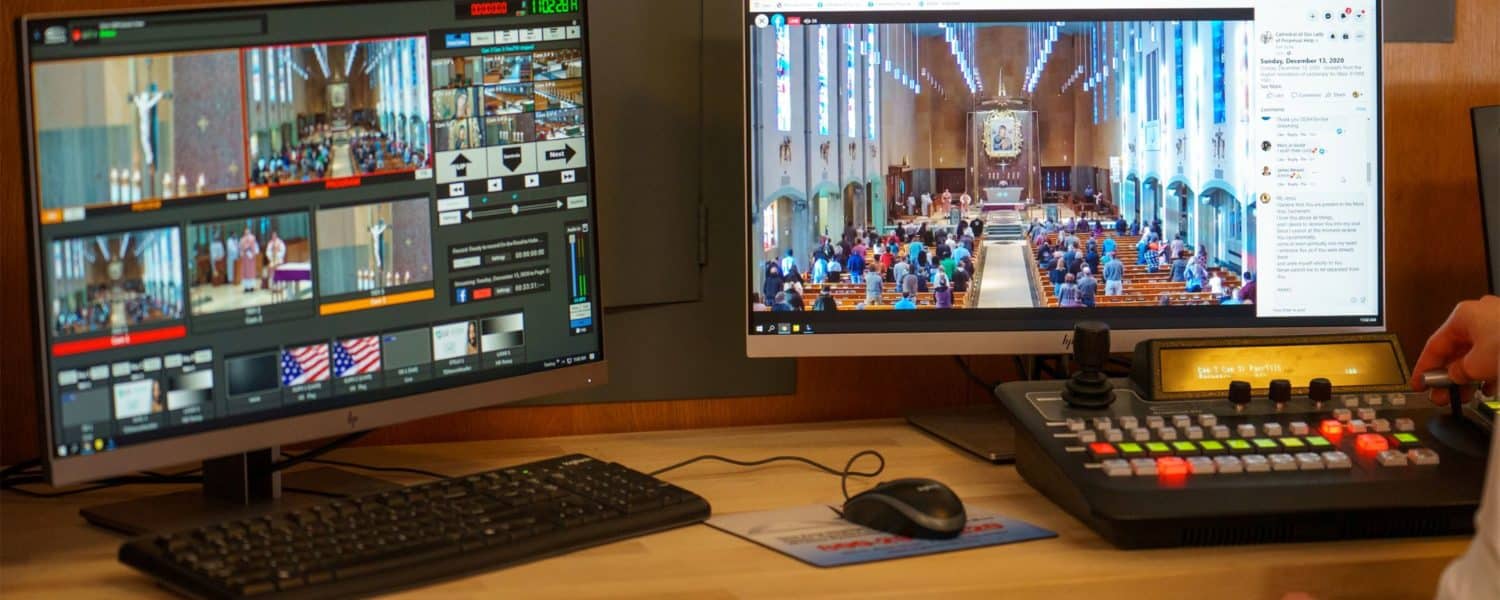By Graham Sharp
Hybrid worship, a blended approach to in-person and online ministry, has proven to be an effective way for churches to increase their audiences through video.
The hybrid worship approach provides an accessible and welcoming way for all people to join your faith community, regardless of location.
It also presents the opportunity to provide more services to your community, even creating revenue streams for your church by producing professional video content of events, such as weddings, etc.
Every church can create a hybrid worship experience, but without some careful research and planning, the technology can appear overwhelming.
Getting Started – Choosing a Solution
There are two aspects to hybrid worship: 1) the capture and production within the church and 2) the streaming and distribution to the audience.
Both processes can appear to be very techy and intimidating to non-technical volunteers, so start by doing some research and finding an integrated solution that’s simple to install and easy to use.
Let’s start with cameras. Today, most cameras are robotic and can connect to the production system using a single network cable. This cable carries video and audio back to the production system and power and control in the other direction to the camera. Utilizing a single off-the-shelf network cable in this way makes installation easy and unobtrusive.
Today integrated production systems are typically software, running on an off-the-shelf server or PC with all the tools required to produce and stream professional-looking video content integrated into a single, easy-to-use user interface.
There are several integrated production systems available on the market today. Look for one that includes the automation of simple tasks so that once it is set up, it does not require a dedicated and trained production crew.
Automation Is Key
Think of your production as two processes: set up or pre-production and the live event.
Choosing a system with automation enables you to set up your production ahead of time without the pressure of the live event. You can robotically position the cameras, even pre-program camera moves, cue still images and clips, create graphics and templates and even add special effects such as wipes or dissolves. Create the look and feel you want offline, in your own time, and record the entire process in automation.
Once you have automated your show, you can use it every week, with the operator only clicking a single button to advance you through the service.
For example, you could start with a view of the congregation. When the priest walks to the pulpit, press a single button to initiate the camera moving to the pulpit and a graphic appearing with the presiding clergy’s name.
Then, before a hymn, press another button to make the camera turn towards the organist, and an image appears to show the hymn’s title and words. And so on, including turning on and off the live streaming.
In the broadcast world, this type of automation is generally called using macros.
Macros can automate any series of production steps together to be played out at the touch of a button during a live event. Macros can be stored, edited, timed, and used to build a library of “automation” content for future events, contributing to the consistency of the look and feel of the service and the reduction in on-air mistakes. Plus, ensuring that the minimum number of buttons will need to be triggered during services.
Use Graphics to Improve Production Values
Another helpful tip is to use logos and graphics to create a compelling virtual experience for online viewers. Consider including your church logo, using lower-third titles, and showing Bible verse graphics to produce a more inspirational look for your live streams.
This simple yet effective approach can include elegant graphics, pre-made announcements, and logos in your worship services. Look for a system that includes editable templates that can be automated on and off to get your message across.
The use of effects is another way to maintain and reinforce a sense of community and keep your congregation connected. For example, use a picture-in-picture effect to show the minister and congregation’s reactions and allow those at home to see the in-building members.
Part of feeling connected means feeling engaged. The more engaged people are, the longer they will continue to watch and the more likely they are to return.
Create Visual Connections with Cameras
Using PTZ robotic cameras (the acronym stands for pan, tilt, and zoom) will enable you to place static cameras throughout your place of worship, providing multiple camera positions to capture every aspect of your ministry.
These cameras are then robotically controlled from the production system, typically through pre-programmed automated macros, giving the resultant video content a feeling of depth, space, and movement.
PTZ cameras are inexpensive enough that several can be used in a small area. Over recent years, they have become increasingly sophisticated, with image processing algorithms to ensure high picture quality even under low light conditions. Optical zooms of up to 20x are standard in most PTZ camera models.
Look for a streaming solution that offers integrated control of robotic cameras, preferably with an easy-to-use user interface. It will ensure that church members can comfortably control one or multiple cameras – either live during the service or by macro automation.
Amplify Your Message – Stream and Record
Streaming worship services can offer churches numerous benefits. It can expand your reach, connect with people outside your community, or reconnect with former members who have moved away.
Even small congregations that had once struggled to reach outside the walls of the church can expand its reach. For example, some people may prefer to attend online services for health and safety reasons.
Whether a congregation member is in a nursing home, in quarantine, or cannot attend in person, streaming enables them to still be part of the congregation and experience the service.
Streaming can also amplify the worship message. Online services can be watched live on a variety of streaming platforms such as YouTube and Facebook. Most integrated production systems provide a direct and simple approach to online streaming.
Some also offer the ability to multi-cast so the worship service can be simultaneously shared across multiple online platforms. This is a simple and effective way to ensure you will reach the congregation online, everywhere.
Also, I recommend recording your services on your church’s website for later viewing and sharing.
Streaming and the hybrid worship approach allow more people access to your church’s teachings through video. To be done successfully, a church must have the right equipment for its staff.
Look for a system that is simple to install and easy for you and your volunteers to use. Pre-plan your services and live worship events to produce inspirational content and stream it everywhere.
Graham Sharp is the chief executive officer of Broadcast Pix, which offers the complete toolset required to make great programs, elegantly integrated and easy to use, www.broadcastpix.com.
















